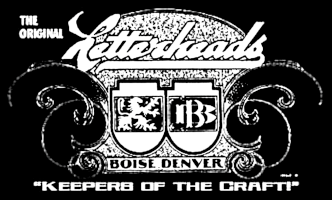This is a can of size I found from more than 30 years ago. It's quite full because after I used it a couple of times, I couldn't get the cap off so I switched to another brand.

Here's the back label (hmmmm, you can actually read it without a magnifying glass)

To solve the cap "problem", I put a sheet metal screw into the top. I do this with all my paints. To remove the size, I tip the can and remove the screw, squeeze out the amount I need and return the screw before tipping it back up. By doing it this way, the air that gets in has to go thru the paint, picking up vehicle as it does and a skin will not form.

To do the test I applied the size in about a 3"x3" square. For a control sample, I did the same with a much fresher Rolco size next to it.

Because, normally, I only apply a very thin film of size for the mostly small signs that I do, I applied a heavier coating (not real heavy tho) on each sample, dividing them in half. ( this heavier coating is probably closer to what most folks use in surface gilding and is what I would use on a bigger job) I think you can see the difference in color on the Yellow Kurtz sample.
THE TEST:
First, I was concerned about mixing all the size so I shook it for quite a long time and then set it upside down for a while and then shook it again.
Room temp was 68 degrees with 28% humidity.
I was concerned about how well the Kurtz would dry so I made another sample with just the Kurtz and set it under a quartz heater which raised the surface temp to 94 degrees (I hoped that would speed up the drying test)
After 12 hrs, both the Rolco and Kurtz were still too wet. The sample under the heater was dried hard (I tried to apply a gild but it was spotty at best)
At 18 hrs, both the Kurtz and Rolco took a decent gild although the heavier size side, was a bit dull.
At 21 hrs, both samples took a very good gild and at 24hrs, the thinner samples had a spotty gild.
In all the tests, I used patent leaf pressed on with a finger.
Conclusion......I have a pint of usable size.
When this side of the site was down yesterday, I found this by Rick Glawson on the original site. (An excellent read)
http://www.theletterheads.com/glawson/goldsize.html
I hope Kent can fill in the history of this brand and any insite/info that is helpfull.
Joe
 Denver Chapter of the Letterheads
Denver Chapter of the Letterheads